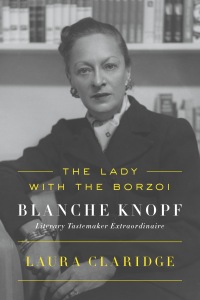The Lady with the Borzoi: Blanche Knopf, Literary Tastemaker Extraordinaire, by Laura Claridge. Ferrar, Straus, and Giroux. 416 pages. Hardcover $30.00.
Jewish people like to call themselves “the People of the Book.” Since this proud appellation is self-applied to many Jews who have little interest in “The Book” (the Torah), it seems only proper to recognize the fact that the heart and soul of the Knopf publishing house was Blanche Knopf, even though her husband’s full name, Alfred A. Knopf, was the company name. Blanche, a brilliant and dedicated genius, was a totally secular Jew. As was Alfred. Books were Blanche’s religion. 
Laura Claridge’s biography effusively explores the implications of Blanche’s unique accomplishment, one fully against the time in which she was born and raised with respect to women’s roles and opportunities. Born in 1894 to Julius and Bertha Wolf, she and Alfred Knopf had planned to launch a publishing house even before their marriage in 1916. The pre-nuptial agreement obtained verbally from Alfred was that husband and wife were to share equally in all aspects of this venture. That equal sharing did not happen, and so the marriage was troubled from the start.
For fifty years, Blanche suffered from being slighted – not always silently. Though he knew better, Alfred always played the role of the mastermind, positioning Blanche as a fortunate assistant. But nothing could have been further from the truth. He took advantage of her, and she put on the best face that she could, building a reputation as a remarkable judge of talent and as a businesswoman who could bring that talent into the Knopf fold.
Putting on the best face included developing a personal style in bearing, clothing, and all aspects of appearance and expression. The Knopf offices and residences (except for those exclusively Alfred’s) also reflected her inimitable taste. She even designed the borzoi colophon for the Knopf imprint. Blanche created herself, driven by the need for acceptance and the desire to prove her worth. As a party-thrower, Blanche had few peers. Artists, composers, performers, intellectuals – they all showed up at her events, and she at theirs.

Laura Claridge / credit Marion Ettlinger
There are many painful episodes in Claridge’s analysis of how and why Blanche made her choices and how she dealt with the consequences of those choices. Throughout, Claridge’s understanding, empathy, and sure-handed use of her sources make Blanche come alive.
One consequence of the more or less agreed-upon “open marriage” that emerged from Blanche’s shattered expectations was her series of affairs, often with prominent figures in the arts.
But that’s not the fun part of delving into Blanche’s life. The fun part is watching her build the firm, making things happen often in spite of Alfred’s interference or indifference – or hostility.
From the beginning, the Knopf enterprise imagined itself as a sort of boutique establishment dealing in refined literary sensibility. Early on, Blanche began to build their list by getting permission to publish English translations of established and up-and-coming European writers. Laura Claridge details Blanche’s scores of trips to Europe to meet and court her favorites, as well as her ardent hospitality to these writers when they visited her in New York or elsewhere. She developed an extended family of writers (and editors and agents and cooperating publishers) that brought her greater emotional rewards than did her family of record.
Knopf became a prestige house, and it didn’t lose that aura even when, many decades after its founding, it was absorbed into Random House (the proliferation of mergers and imprint swapping in the publishing industry is ongoing).
For all of its successes, its many award-winning titles (including a pile of Nobels and Pulitzers), Knopf had very few blockbuster best-sellers. It did, however, establish an enviable and lucrative backlist – titles that sold well year after year and hardly ever went out of print. That was the whole point of careful selection: not the short run fad, but rather the book with the long future. These floated the boat, as did having many titles selected by the Book of the Month Club and the Literary Guild Book Club.
Here is very short list of authors published by Knopf during Blanche’s lifetime, either original titles or first English translations: Sigmund Freud, Albert Camus, André Gide, Jean-Paul Sartre, Simone de Beauvoir, Ilya Ehrenburg, Mikhail Sholokhov, Thomas Mann; John Updike, Julia Child, Carl Van Vechten, James M. Cain, Willa Cather, John Hersey, Raymond Chandler, H.L. Mencken, William Shirer, Dashiell Hammett, and Langston Hughes; Wallace Stevens, Elinor Wylie. Beyond the list is Laura Claridge’s energetic and alluring recounting of their various relationships with Blanche.
Blanche Wolf Knopf died in 1965, shortly after her company’s fiftieth anniversary. Unlike her parents, who were buried in Brooklyn’s Salem Fields Cemetery affiliated with Temple Emanu-El (where funerals for friend George Gershwin and father-in-law Sam Knopf were held), Blanche chose the incineration route.
While leaving, perhaps, some aspects of Blanche’s outer and inner lives their mystery, Laura Claridge has provided as many facts and insights as anyone needs to understand and admire the industry, creativity, and courage of her subject. At the same time, she has masterfully set Blanche Knopf into an exciting milieu – the American publishing industry from WWI to the first glimmers of a war in Vietnam. We have here a spellbinding tale of shifting tastes and hard-won survival in the literary world.
Next time you think about “People of the Book,” think about Blanche Wolf Knopf.
This review appears in the June 2016 issues of Federation Star (Jewish Federation of Collier County), L’Chayim (Jewish Federation of Lee & Charlotte Counties), and The Jewish News (Jewish Federation of Sarasota/Manatee).
